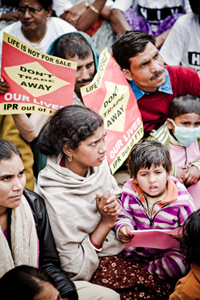Where Does the UN Go From Here?
The TREAT Asia Report Interview: Michel Sidibé, Executive Director of UNAIDS

Michel Sidibé was a special guest at
a Valentine’s Day HIV prevention
drive aimed at Bangkok sex
workers. Photo credit: UNAIDS.
|
Michel Sidibé has been the executive director of UNAIDS since 2009. A native of Mali, he has worked to advance global health and welfare for almost 30 years. Widely respected for his humanitarian work, Sidibé also serves as Under-Secretary-General of the United Nations.
___________________________________________
TREAT Asia Report: Many children born with HIV, in Asia and elsewhere, are now on the cusp of adulthood, even as their options for affordable antiretroviral treatment (ART) are becoming increasingly limited. TREAT Asia is launching a study of drug resistance among children and adolescents, but it is clear that without access to second- and third-line drugs, the future of these young patients is not secure. What can be done to extend the supply of essential medicines to include these more expensive, less accessible drugs?
Michel Sidibé: The number of young people who have already benefited from ART for several years and will require second- and third-line drugs is indeed expected to increase further, and we need to ensure that such drugs are available everywhere.
UNAIDS advocates drug research and development to optimize pediatric and adult drug regimens. The aim is to make them longer lasting, easier to ingest, less toxic, and less likely to induce resistance. In the medium term this will hopefully reduce the need to switch from one regimen to another. In the shorter term, UNAIDS, in collaboration with other organizations, advocates both reductions in the high prices of existing second- and third-line drugs, as well as sustained and increased funding for AIDS treatment.
Governments do have a responsibility in this respect. They need to include second- and third-line antiretroviral regimens in their national essential drug lists, ensure training of health providers in their use, and allocate sufficient resources to pay for them. In many countries, this should be possible. For countries that cannot afford these costs, however, international solidarity must ensure access.
Finally, we should not forget that stopping new HIV infections among babies is the most important measure that can be taken to reduce treatment need among children. UNAIDS has called for the virtual elimination of new HIV infections among children by 2015. In Asia this requires addressing the needs of vulnerable mothers and their partners.

More than 3,000 protestors marched
through New Delhi on March 3, raising
their voices against free trade negotiations
between India and the European Union
that could threaten access to generic
HIV medicines. Photo credit: Rico
Gustav, APN+.
|
TA Report: One of the goals of UNAIDS since you became director has been to put an end to mother-to-child transmission of HIV. Despite Asia’s relative economic strength compared with Africa, the region performs more poorly when it comes to implementing these interventions. What can be done?
Sidibé: The key is integration—investments for women’s health must be comprehensive. We need to shift our perspective of considering programs to prevent mother-to-child transmission of HIV as separate from maternal and child health programs. We must also increase demand for them. Successful experiences in countries such as Cambodia are showing that the increased involvement of networks of people living with HIV and civil society is making services more effective and efficient.
TA Report: Ongoing free-trade negotiations between India, which manufactures most of the world’s generic ARVs, and the European Union have raised concerns about consistent access to high-quality generic drugs. The possibility of further limiting the supply of generics at a time when donor nations are trimming back their commitments to universal treatment presents a grave threat. What will the UN do to help maintain and expand generic production?
Sidibé: UNAIDS’s vision of zero AIDS-related deaths cannot be achieved if people living with HIV do not have sustained access to affordable medicines. Generic drugs are playing a crucial role in current treatment gains. Countries should not trade away the public health of their people for other trade gains. I urge all countries to ensure that efforts towards universal access to HIV prevention, treatment, care, and support are not impeded by bilateral and multilateral trade agreements.
Countries must fully use the flexibilities provided in the World Trade Organization’s TRIPS Agreement and the Doha Declaration, as needed, to achieve universal access to HIV treatment. These flexibilities set out to protect public health and provide access to medicines for all; they must not be undermined by other trade agreements.
TA Report: Unlike in sub-Saharan Africa, the AIDS epidemic in Asia is largely concentrated within vulnerable communities. But programs aimed at these marginalized populations—men who have sex with men (MSM), injection drug users, sex workers— have been significantly underfunded. What is the UN’s plan to help change the priorities of local and regional governments and funders to support programs targeting these groups?
Sidibé: Compelling evidence shows that for Asia to turn the tide on AIDS, country strategies have to focus on people at higher risk of HIV infection. Asian countries cannot afford to ignore the HIV prevention needs of MSM, people who inject drugs, sex workers and their clients, and transgender people.
The Report of the Commission on AIDS in Asia put it plainly: Political leadership on HIV in Asia is the key, and that’s why our strategies in Asia focus heavily on building and sustaining leadership to ensure that funded programmes are in place for those most affected.
TA Report: Harm reduction has been shown conclusively to help stop the spread of HIV, but harsh attitudes toward drug users prevail in many countries. Nonetheless, harm reduction efforts have begun to find a foothold in a few places such as China and Viet Nam. What has happened there to turn the tide in favor of harm reduction and how could that could be applied in neighboring countries?
"Countries should not trade away the public
health of their people for other trade gains.
I urge all countries to ensure that universal
access is not impeded by trade agreements."
|
Sidibé: A combination of civil society pressure, backed by strong scientific evidence, has helped the political leadership in these countries make tough decisions.
Countries are learning from the example of China and Viet Nam. The most dramatic turnaround in favor of harm reduction has been in Malaysia. In response to a Millennium Development Goal report that suggested Malaysia was lagging behind, the government took rapid action to see how and where this could be best addressed. They reviewed their singular reliance on compulsory detention as the response to injecting drug use and pushed the cabinet to endorse a switch to harm reduction in November 2005.
TA Report: Many Asian countries are now solidly in the ranks of middle-income countries and receive only moderate foreign aid to support their AIDS programs. How can regional governments be convinced to dedicate more of their own public funds to HIV/AIDS prevention, treatment, and care?
Sidibé: Gains in the AIDS response are fragile and funding must be a shared responsibility. Funding decisions for HIV should have a human face. Resources must go to the communities that need them most and should not be based on economic indicators alone.
While we urge donor countries to increase their allocations to the AIDS response, we also underline that domestic investment for AIDS must be increased. A new Domestic Investment Priority Index developed by UNAIDS shows that many developing countries with strong economies—including a number in Asia—can meet a substantial portion of their resource needs from domestic sources alone.
Governments understand results. I am hopeful that by showing results in the AIDS response, we can make the investments sustainable and predictable.